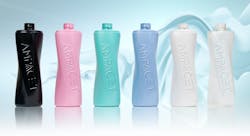Silky Bliss sounds like the name of a refreshing beverage or a chocolate treat, but it’s actually a masterbatch that Ampacet Corp. said will impart “a sophisticated, modern look” to packaging for maximum shelf appeal while enhancing recyclability.
The Silky Bliss collection can be used in PET and rPET packaging for “an elegant silky surface treatment,” according to Ampacet.
The product is available in six shades — Diablo, Akoya, Crushed Ice, Mint Breeze, Alaska and Sakura — and the entire product range is near-infrared (NIR) transparent, which allows for sorting with near-infrared optical sensors at recycling facilities. The Silky Bliss collection features very low light reflection for better readability of packaging graphics and text.
It enables the reuse, recovery and recycling of packaging waste and allows recyclers to support the circular economy, the company said.
Consumers increasingly consider the environmental impact of a product’s packaging when doing their shopping, according to the company. The European Plastic Strategy & Circular Economy Action Plan calls for a minimum of 50 percent of plastic packaging waste to be effectively recycled by 2025.
In addition to the six stock shades, Ampacet said it can produce custom colors.
Use of Silky Bliss does not require mold modifications to achieve a matte effect, resulting in significant cost reductions, according to Ampacet.
Ampacet, based in Tarrytown, N.Y., operates worldwide with more than 2,000 employees.
Ampacet Corp., Tarrytown, N.Y., 914-631-6600, www.ampacet.com
About the Author
Bruce Geiselman
Senior Staff Reporter Bruce Geiselman covers extrusion, blow molding, additive manufacturing, automation and end markets including automotive and packaging. He also writes features, including In Other Words and Problem Solved, for Plastics Machinery & Manufacturing, Plastics Recycling and The Journal of Blow Molding. He has extensive experience in daily and magazine journalism.
